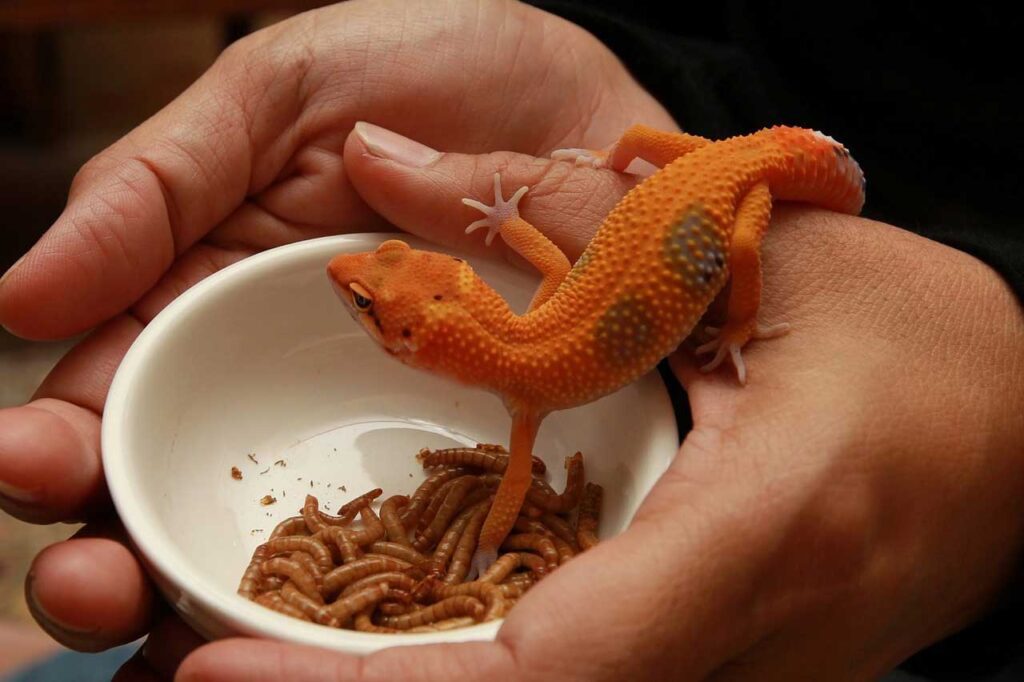Content |
|---|
Each species of reptile has specific feeding requirements manifested in digestive and metabolic adaptations, that define water requirements, calories and nutrients; they also follow an annual nutrition cycle, which relates to climatic/environmental conditions. (1)
The reptiles in captivity their diet is unlikely to be the same as they would be in the wild, so nutritional problems are frequent when providing poor diets, Inappropriate, unbalanced or excessive, resulting in accelerated growth and obesity among other things; added to this, the stress of captivity adversely affects food intake and nutrient utilization. However, a diet connects and a good management in the diet, can be used to effectively minimize the effects of stress, either by captivity, disease or surgical procedure. Being a base the diet that imitates the one that the animals would find in freedom. (2)
The quantity and quality of food It is important, so they should be fed with food of the highest quality: fresh food being the ideal: as old foods can become contaminated with bacteria and fungi. Low metabolic rate and high efficiency in the conversion of reptile food, frequently leads to overfeeding of captive specimens, the amount of food provided should at least ensure normal growth or maintenance of the weight of the animal (3).
The frozen food for more than 6 months are inappropriate, as they lose their nutrients: however, short freezing periods increase the digestibility of some plants, although this cannot be applied to fish, as it reduces its thiamine content. Cooking food softens it: however it is recommended to give uncooked food, especially to the herbivorous reptiles (4).
Unlike mammals, reptiles decrease their energy expenditure at low temperatures (5).
1.-Importance of temperature in digestion
Being creatures ectothenics ⓘ your body temperature is affected by ambient temperature, because of this, food intake, digestion, nutrient absorption and metabolic rate changes.
Therefore,, a reptile in a cold environment lowers its metabolic activity. consequently decreases your intake of food and water (many species stop feeding when outside the 20-32°C range): decreases nutrient absorption and digestion, ceasing once temperature drops to 6°C; which gives rise to the putrefaction of intake.
Absorption of putrefactive toxic products, can be causing mortality during hibernation or syndromes such as paresia ⓘ of the later members. So reptiles must be kept in their appropriate temperature range so that they can carry out a correct digestion, unless preparations are made for hibernation, in which case the animal will be no longer fed to avoid the aforementioned problems (6).
In the case of the Turtles poor digestion and constipation are life-threatening conditions: as it increases intestinal distention compressing the lungs and most of the blood vessels, due to its anatomical position (7).
On the other hand the undernourished reptiles in a vivarium that has a warm temperature, lose weight quickly due to a high metabolic rate: however, prolonged undernourishment with a warm climate leads the animal to present starvation evidenced by the state cachexia ⓘ of the animal and the decrease in metabolic rate despite the temperature (8).
2.-Nutrients needed according to the type of diet
The digestive tract of reptiles varies from relatively coitus and simple to digestion and absorption in the small intestine (carnivores), to a long one for fermentation in the large intestine (herbivores). carnivores (including insectivores) use protein and fat as a source of energy: herbivores use soluble carbohydrates and fermented fiber: while omnivores use the 3 sources (9).
2.1.- Carnivores
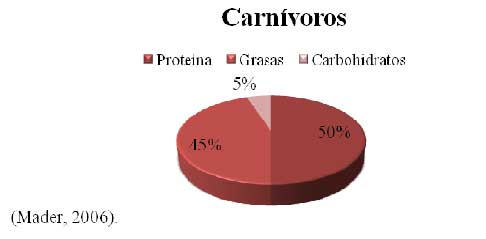
Healthy carnivores consume large amounts of protein (25-60% of Metabolizable Energy [EM]) and fat (30-60% of MS) (see Fig.l). Carbohydrate intake is limited to those found in herbivorous prey. Carnivorous reptiles require high quality protein, which is irrelevant when feeding on full prey: however it is critical in reptiles that need assisted feeding. Non-Meat Sources of Protein, like corn gluten, soy and casein are unsuitable, as well as diets for dogs and cats, since as proteins they contain some of the previous elements: they also require additional nutrients to the diet such as the amino acid taurine and fatty acids such as arachidonic acid (10).
2.2.-Omnivores
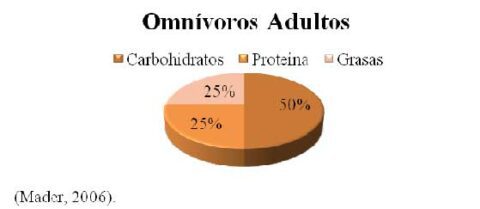
The omnivorous reptiles tend to consume more protein and fat when they are juveniles than as adults (e.g.. Red-eared turtle (Trachemys scripta) and Bearded dragons (Pogona barbata)), so the recommendations for animals that carry this type of diet is that they maintain a meat-based diet when they are juvenile and gradually introduce and increase the amount of plant matter as the growth of the animal decreases, a small amount of meat can be maintained throughout the life of the animal (see Fig.2) (11).
In some situations it is beneficial to limit protein intake, since limiting nitrogen consumption inhibits the development of nitrogen oval follicles pre-hibernal, egg production is stimulated when turtles have protein reserves, this also applies to other reptiles that mature their follicles in this way (12).
2.3.- herbivores
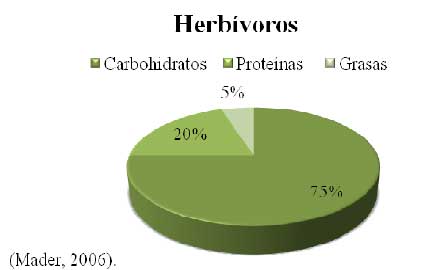
Healthy herbivores consume a 15-35% of protein MS, less than 10% in fat and more than 50% in carbohydrates (see Fig.3). Fiber intake goes from 15% to the 40% of dry matter, this fiber is fermented in the large intestine where it is converted into chain fatty acids, which nourish the enterocytes and provide them with energy.
The herbivorous reptiles have large proximal colon, in addition to having several septa and valves (this last in iguanas), which are associated with subsequent fermentation and decrease the passage of fiber, which gives time for good digestion of cellulose by symbiont bacteria and protozoa: it is believed that the Nematodes as pinworms ⓘ and attractidae ⓘ in iguanas, help mix and break down food and even regulate intestinal flora.
The reptiles can get from 23-64% of its digestible energy from fiber: lack of fiber in the diet or excess in fast-fermenting carbohydrates can lead to a detrimental change in the intestinal flora, Likewise, excess fiber limits calorie intake and inhibits the absorption of minerals.. (13)
The protein requirements of the herbivorous reptiles range from a 14-35% of Dry Matter. The amount of protein tolerated is not well documented and its requirements vary according to quality and quantity, nitrogen excretion and its effects at the renal level lead to conservative estimates.
The highest percentage of protein is recommended for growth and when the animal is stressed. It has been shown that the food selected by iguanas free-living is richer in protein (13-33%) than the one they reject (7-17%) and it has been shown that the iguanas tend to grow better when they have a diet with a 25% of dry matter corresponding to a 5-8% protein.
The protein requirements tend to decrease around the 24 months of age. Plant proteins do not have enough essential amino acids (lysine, methionine, cystine, tryptophan and threonine) and vary in their amino acid content; while high-quality animal protein contains the optimal proportions, however it contains fat, phosphorus and purines, which can cause gout. Even so, there are plants with high levels of purines (50-150mg l00g) like asparagus, whole grain cereals, cauliflower, beans, peas, Spinach, wheat mushrooms and germ (14).
The herbivorous reptiles will have digestive problems if the diet contains more than 12% of fat (15).
3.- Water
All the captive reptiles must have access to water. The way to administer it will be according to the requirements of the species, for example certain lizards need to see the reflection of light in water droplets to drink it, some lizards and Snakes may not accept water in containers; but usually lick small amounts of water, as drops on foliage; so water is provided by drip systems, can be a mist injector or bottles with sprinkler (1 or 2 times a day). There are devices on the market to offer water in this way, for example the “big dripper” and the “Little dripper” (see humidity section) (16).
In species that take water from containers, it will be ensured that it is large enough to allow the reptile to bathe in it., for the land turtles the water level should be shallow, it is recommended to reach the plastrón ⓘ; for iguanas and Snakes it can be a little deeper, to these the baths also help them with the molting of skin, stimulate defecation and drinking (see Fig. 7 and 8).
Immersion baths can be carried out by the owner in case an area for this purpose cannot be placed inside the terrarium; bathrooms should be every 5-10 days and diary in newborns.
When reptiles are placed in immersion baths they have the ability to take in water from their cloaca, this is known as “cloaca drinking“, however this should not replace the oral beverage form, because it cannot correct the balance of extracellular fluids (17).
Some animals refuse to drink water from plastic containers, this may be because they change the taste of the water or give it a certain smell., this is corrected by changing the plastic container to a glass container, stainless steel or ceramic (18).
The water provided must be clean, preferably use bottled water, tap water is chlorinated, so its immediate use is not recommended because chlorine can harm the animal, the water should be left to stand 24 hrs to make chlorine harmless, if the quality of the water is doubted, it can be chlorinated, Adding 2-4 liter drops and then let it sit as mentioned above (19).
4.- Types of food
4.1.- Vertebrate prey
The most common prey are mice and rats of various sizes and ages, other prey on offer include fish, frogs, toads, lizards, Snakes, chickens, finches, ducks, Gerbils, rabbits and guinea pigs.
For the carnivores, whole dam provides essential amino acids and high-quality protein, as well as lipids, trace vitamins and minerals. Healthy and well-fed prey are considered complete and balanced. You have to offer 2 to more different species of prey, as there are differences in nutrient content between vertebrate prey: dependency on a single prey is common in snakes and may be unavoidable (20).
The nutritional composition of the prey is affected by age, health, diet and environment, for example old mice may be obese or underweight: when they are obese they usually contain more than 50% of fat in your body, which leads to the predator suffering from nutritional deficiencies and obesity.
When the prey is losing weight, provides the predator with excess minerals and few calories, leading to low energy intake. Studies have been done regarding the nutritional quality of the “pinkies” (newborn mice), so far it is only known that they provide enough calcium and vitamin A, however more information is needed, reptiles fed with “pinkies” should supplement their diet with supplemental invertebrates or adult vertebrates, to ensure a complete diet (21).
There is a risk that both wild and commercial prey can transmit parasites and pathogenic organisms to reptiles., one measure that is suggested to prevent infection of the animal is freeze and thaw the prey before providing it to the animal.
A problem of giving live prey is that they can seriously hurt reptiles through scratches and bites (see fig. 93) so it is better to give dead prey, rodents that have around 2.5 weeks (eyes open and hairy) they must be slaughtered before being offered to the reptile (22).
The freshly killed prey they are just as nutritious as live prey and freezing for short periods does not destroy the nutrients, while foods frozen for more than 6 months result in odor deterioration, flavor and texture (the fat becomes rancid and alters the flavor) and labile nutrients are lost; The degree of hydration of the prey and a thawing method that preserves the humidity of the animal should also be taken into account., because carnivorous reptiles not only depend on their prey as a source of nutrients but also on how water fountain (23).
The choice of kind of rodent what you eat is important; for example one royal python (Pvthon regius) it will first devour a gerbil which is more like a wild mouse, than an albino or colored mouse (24).
Some species are difficult to feed in captivity as their feeding is specialized: for example there are snakes like the arboreal Jackson (Thrasops jacksonii) that only feeds on lizards, the american garter snake (Thamnophis spp.) or water snake (Natrix spp.) they feed on large fish such as lucio, Therefore, they must be fed with fish of a similar size to what they would eat in the wild. (25).
The recommendations for prey size is to give large prey to large animals and small prey to small animals. One measure that can be taken into consideration is that the size of the prey must be 10 to the 30% of the body mass of the predator (26).
4.2.- Invertebrate Prey
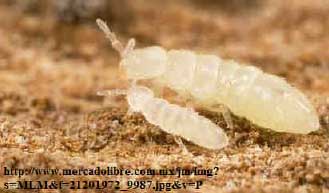
In the market you can find invertebrates such as crickets, tenebrios, zophobas, silkworms and butterflies, wax worms and moths, cockroaches, flies, fruit flies, worms, caterpillars and springtails (springtails) (see Fig.4). of free life, crickets can be obtained, chapulines, katydids, beetles, praying mantis, stick insects, lobsters, snails, mealybugs, etc. Knowledge of the biology of invertebrate prey; as well as its maintenance is important if you want to maintain and reproduce (27).
Many species provide at least 30% of protein MS, 40% of fat and less than 15% of carbohydrates, however the invertebrates that are sold in pet stores are uneaten: so they do not contain optimal levels of fat, protein and other nutrients. Invertebrate protein quality is equal to or better than soy protein; but it is less than milk albumin, which is ideal.
It is believed that in insectivorous reptiles, just like in chickens, your diet is limited arginine ⓘ and metionina ⓘ, especially the arginine due to its low synthesis in the uric acid cycle (28).
It is recommended add supplements to the external surface of invertebrates as calcium and vitamins before giving them to the reptile, because invertebrates have a low calcium content (except for snails and earthworms that ingest calcium-rich soil), which prevents nutritional deficiencies, however, the fact that they are given sprinkled insects does not rule out deficiencies or toxicity (29).
Generally in reptiles that are fed daily, it is recommended that their feed be dusted once or twice a week, supplementation decreases as the animal grows. Insects that have been in contact with pesticides or herbicides should be avoided; the size of the prey to offer should not be greater than the width of the predator's head (30).
The insects must be alive at the time of giving them to the reptiles, since the movement of prey stimulates predation behavior, it is recommended to give variety to the diet (snails, slugs, beetles, mantis, flies, moths) and not be pigeonholed 1 or 2 elements, They must also be healthy and well nourished to be of benefit to the predator.. Insects that have not been ingested should be removed from the terrarium as they can attack the reptile.. Avoid fireflies and butterflies as they are toxic (31).
4.3.- Green matter
The proportions of green leaves, fruits and vegetables vary between species; for example, desert and arid climate species tend to accept and metabolize hay better, cacti and dried fruits and your fiber intake should be 15% of dry matter; the fruit in these species is often rapidly fermented, can lead to lactic acidosis or diarrhea; In addition to reducing the amount of fiber.
In contrast, reptiles from tropical climates prefer sweeter foods and tolerate a greater amount of fruit in their diet and their intake of fiber is lower.. Many reptiles are oriented by the color of food, liking those that have red colors, yellow and orange; they really like strawberries, apples, pumpkins, bananas, mango and sweet potatoes (32).
- Green leafy vegetables: there are a lot of salads which include endive. Escarole, Cos, amaranth, cabbage cabbage, dandelion, Kale, mustard greens, Spinach, in stores they already sell some chopped and packaged salads and one that herbivorous reptiles really like is the spring mix. Common lettuce should not be among the main elements of the diet, because it is not very nutritious (all types of lettuce need supplementation). however they are nutritionally better than most feints (33).
- Other vegetables: carrots, Peppers, pumpkins and sweet potatoes give a lot of color and are tasty, legumes are a good source of calcium and protein like beans, alfalfa and peas (34).
- Fruits: Most of the tropical reptiles eat fintas among the favorites are the banana, mango and papaya, other feints are the apple, fig, guava, Kiwi, melon, peach, pear. pineapple, grapes and watermelon. Many enjoy berries like blackberry, blueberry, Blackberries, raspberry, and strawberries (35).
- Leaves and saplings: Land turtles and iguanas feed on clovers, dandelion, grape leaves, Hibiscus, roses, pothos or telephone and nasturtium (36).
- Hay: provides the 25-40% of crude fiber, however the qne found in trade provide less than half, there are commercial hay in pet stores, They can also be obtained in foragers, you can also buy products that contain fiber such as cellulose, bran (may irritate the large intestine) or psyllium (37).
- Pastures: the land turtles that are allowed to graze are not selective and can ingest pastures such as Timothy, Orchard, Johnson and Kentucky bluegrass, large species can ingest cacti, shrubs and vines (38).
Care should be taken with plants that contain oxalatos ⓘ, for example: Spinach, rhubarb (NEVER high levels of oxalates), Col, potato already, beet, among others.
The oxalates leave calcium and trace minerals unavailable for absorption; deficiencies occur when this type of plant predominates in the diet: likewise there are goitrogenic plants which contain thiocyanates (Cabbages, mustard, turnip and other crucifers) that cause goiter or hypothyroidism by making iodine unavailable.
In addition to this, herbivorous reptiles present problems because their owners base their diet on lettuce, cucumber and tomato, which have a calcium-phosphorus ratio lower than 1:1, They have a high water content and are not very nutritious, so some type of supplement is necessary and they should be complemented with other more nutritious foods.; to learn more about these problems and their treatments see the section corresponding to nutritional diseases (39).
To avoid the above problems, a well-balanced diet supplemented with calcium is recommended., vitamins, minerals, iodized salt or kelp (care must be taken not to overdose, as goiter will also occur, it is suggested that the amount to be administered be one quarter to one third of the recommended daily intake in humans; which is about 60ug [without taking into account growth or reproduction] or can be given around 0.3 mcg or g / kg / day) (40).
There are plants that are toxic to reptiles, especially to herbivores, so it is recommended to review the annex on poisonous plants (41).
All green matter should be thoroughly washed and disinfected before being given to reptiles and leaves that are already withered are discarded., the food must be chopped to a size suitable for the consumption of the animal, many animals like to fill their food with soil so care will be taken to avoid fecal contamination, most prefer flat plates to bowls (42).
4.4.- Commercial diets
Theoretically the commercial diets are a way to provide a complete and balanced diet, and they are good as long as they meet the adequate supply of calories and essential nutrients for the species in question; so not all of them meet the requirements, since they lack scientific studies and most of the time the components do not correspond to what the label says (43).
- Pellets for carnivores: all carnivores need to feed on prey, but they can get used to pellets. The pellets designed for trout have a high protein and fat content, pellets designed for koi tents and catfish are moderate in protein and fat, the main ingredient of these pellets is fish meat. Some products do not add essential vitamins and minerals and in some cases the extrusion and pelletizing processes partially destroy the labile vitamins.; therefore supplementation is recommended. Also so that the carnivorous reptiles accept the pellets must be presented to them from a young age. In the market you can find frozen dams: mice, Rats, rabbits, chicks and quails of different sizes and guarantee good nutrition and freshness of prey.
- Pellets for omnivores and herbivores: these products contain animal and vegetable ingredients, most contain coloring and flavoring to increase acceptance. Most pellets contain a minimal amount of water (10-12%) compared to fresh salads (85-92%) and insects (60-70%); so pellet-fed reptiles have a lower water intake. Between the pellet ingredients we can find corn, soy, chicken meat, alfalfa and wheat, the nutritional deficiencies of some brands of pellets are compensated with pellets of various shapes and colors, that make them attractive to the owner, but they do not nourish the animal. Plant-based pellets have a 10-12% of fat, while salads contain even less and insects contain between 30 to 60%. Fat is important to omnivores as it provides the calories needed for growth., reproduction and essential fatty acids for the development of vital tissues such as the brain (44).
Now you can find canned insects raised on farms, which have been subjected to a cooking process within the same can, to maintain its nutritional value, taste and aroma, we can find, silkworms, snails, grasshopper, crickets and tenebrios; likewise for herbivorous reptiles, we find canned fruits like papaya, mango and banana.
4.5.- Supplements
The vitamins and minerals should be added to insect-based diets, salads and vertebrates eviscerated or boneless. Vitamin D3 should be included in the diet, unless the reptile spends most of the time exposing unfiltered sunlight or has broad-spectrum spotlights; calcium supplements usually include vitamin D, cholecalciferol or vitamin D3 may be present on labels as cholecalciferol, animal sterol, D-activated animal sterol, irradiated animal sterol or vitamin D3, it should not be assumed that the term vitamin D in the ingredient list is actually vitamin D since it may be vitamin D2 which is unavailable to reptiles..
Adding supplements to water is not recommended as vitamins break down and water intake is affected.; Likewise, its addition to salads can reduce its palatability.; even so it is preferred that they be added to food than to water (45).
The calcium can be provided in the form of lime in stone (38% calcium) or calcium salts: carbonate (40% calcium), lactate (18% calcium) and gluconate (9% calcium); also as eggshell powder (contains high levels of calcium and is safe). The calcium and phosphorus can be supplemented with ground bone (24% calcium and 12% phosphorus) and dicalcium phosphate (18-24% calcium and 18% phosphorus) (46).
The calcium salts they are available in the form of tablets and can be placed in the chest and abdominal cavity of the, vertebrate prey or can be ground and sprinkled on prey and salads. Certain vitamins are broken down by light and moisture so the shelf life of most supplements is restricted to a few months after manufacture, for this reason it is not recommended to use products that do not have an expiration date. Supplements should be stored in a cool, dark place (47) (Mader, 2006).
Most reptile owners like their pets to show off their colors to the fullest and the market has taken it upon themselves to satisfy that need by creating gels that are added to food, containing beta carotenes and antioxidants, that increase the intensity of the color.
